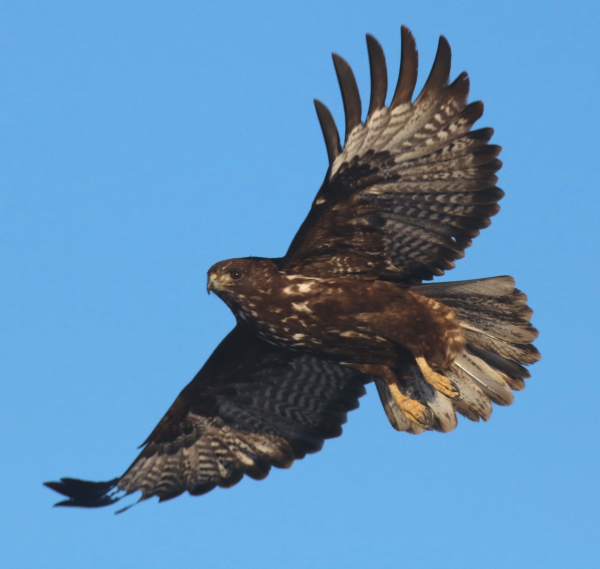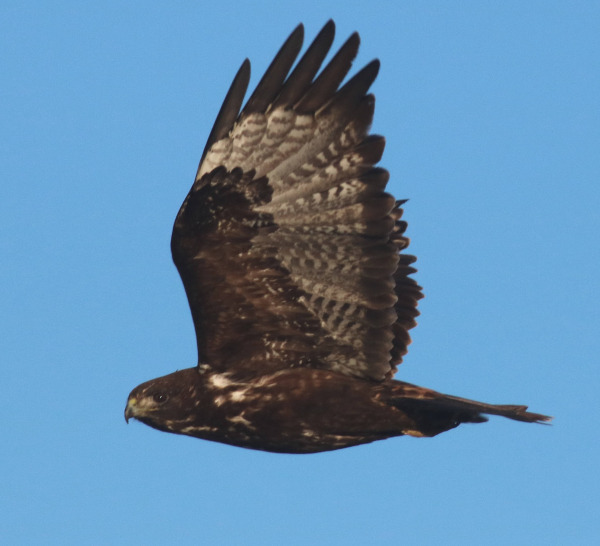
Harlan’s Red-tailed Hawks are intriguing birds, partly because I rarely encounter them, partly because it’s been so hard to get a quality photograph of them. Usually, Harlan’s Red-tails tend to be pretty wary, or timid, and I’m lucky to get a documentary photograph of one. I do have a couple pretty good photos of perched Harlan’s, but they don’t show the impressive markings of the undersides of the wings and tail that are so indicative of this Northwestern race of Red-tailed Hawks.
For a week, spring birds have been migrating north, with a few Red-tails showing up through Thursday evening. With an hour of sunlight remaining, I wanted to drive about eight miles north of my office to take the pulse of the migration a second time that day. There were a few scattered Canada Geese along the way, but as I returned home I sighted a very dark hawk. It quickly became evident it was a dark morph Harlan’s Red-tailed Hawk. It took flight toward the north, and I silently wished I could get within photo range, at least for a documentary photo.
Just a mile down the road, only a mile north of my house, I saw another large dark hawk and thought, “Could it be a second dark morph Harlan’s?” Sure enough, it was a nice female that was perched close to the road. I checked for traffic – there was none in any direction – so turned off my vehicle’s engine to coast into position parallel with the exciting raptor. I took a couple documentary photos of it head-on while it was perched, but then it became really exciting!
The Harlan’s raised its wings high as it jumped upward and began what seemed like slow-motion wingbeats that I followed and photographed in real time. It sure seemed like the resulting photos had the potential of being better than just documentary. These could be really nice images of an impressive bird in flight, I thought.
In retrospect, as always, I had my camera settings ready for just such an opportunity. Even though the sun was in setting mode, there seemed to be ample light; and it didn’t have any tinge of yellow yet. With that in mind, I had my usual “be ready for anything” settings, that included an aperture of f8, and a resulting 1/1250 of a second. Even with that fast shutter speed, I braced my 400mm telephoto lens against the side of the window frame as I followed the hawk’s take-off and flight.

The low angle of the setting sun actually worked in my favor, beaming light straight at the hawk as it took flight and as it was flying to another nearby perch. I pulled into an approach on the side of the road to take a quick look at the resulting images through the small LCD monitor on the back of my camera. From what I could make out from the mini-images, they might be better than documentary photographs.
The real test would be the full view on my laptop computer – my digital darkroom. A mile down the road, on my desk, in my office, I checked the Harlan’s photos one after another – and I was excited, photo after photo! What a bird, what an opportunity, what nice images, I thought. Great action. Hooray!
One thing that I always find interesting, if not unusual, about Harlan’s is their tail feathers. They are usually quite different from Red-tails and may have some gray and black and red-orange coloration with unusual markings that may include spots and swirls. This is quite true with the Harlan’s illustrated here, and although you can see the underside of individual tail feathers quite vividly, the upper side of these feathers are colored dark brown with hints of gray and orange. I’ve found that all the Harlan’s tails I’ve seen have been quite unique, and I thing the underside of the primary and secondary wing feathers are also very interesting.
There’s a little more to this story that I want to share too: Harlan’s Red-tailed Hawks are presently considered a subspecies of Red-tailed Hawks that are best known to nest in the Yukon and Alaska. Harlan’s subspecies has two color morphs – a dark morph, which is most common, and is illustrated here; and a light morph, that resembles a “normal” Red-tail more closely, but can be distinguished in the field. However, before 1973, taxonomists identified Harlan’s Hawks as a separate species; but in ’73 Harlan’s were “lumped” with Red-tails as a subspecies.
During recent decades, some raptor specialists have questioned the lumping in ’73, and it seems 2019 may be the year when Harlan’s are officially “split” into a separate species – again.
My friend Bill Clark, one of the foremost raptor specialists in the world, has been instrumental in the effort to make the case for returning Harlan’s full species status, and he provided me with an interesting bit of information a few years ago regarding dark morph Red-tailed Hawks east of the Rocky Mountains. Bill noted that almost all dark morph Red-tails found east of the Rockies are Harlan’s. To help document that premise, I try to photograph all the dark morphs I find in the Dakotas; and, sure enough, all the dark morph Red-tail photos I have sent to Bill have been Harlan’s.
So, obviously, I will send representative photos of this fine dark morph Harlan’s to Bill; and soon you may find out that the American Ornithological Society has restored Harlan’s Hawks to full species status with some help from documentary photos from a number of people across North America. This time, though, I managed to take some photos even better than documentary photographs – “Keepers.”
Article and photographs by Paul Konrad
Share your bird photographs and birding experiences at editorstbw2@gmail.com